by W.S. Cranshaw* (1/18)
Quick Facts…
- The peachtree borer is the most destructive insect pest of peach, cherry, plum, and other stone fruits in Colorado.
- Damage is done by the immature larvae, which chew beneath the bark of the lower trunk and larger roots.
- Insecticide sprays applied to the lower trunk when eggs are being laid can prevent new infestations.
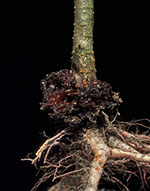
Figure 1: Gumming produced at the base of a tree due to wound by a peachtree borer larva. Photograph courtesy of James Solomon, USDA Forest Service |
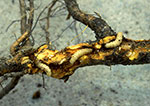
Figure 2: Peachtree borer larvae in roots of a peach. Photograph courtesy of Eugene Nelson, Colorado State University. |
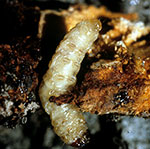
Figure 3: Peachtree borer larva in the base of a peach. |
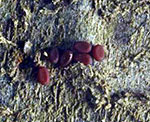
Figure 4: Peachtree borer eggs. Photograph courtesy of Ken Gray Collection, Oregon State University |
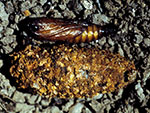
Figure 5: Pupa and pupal cocoon of a peachtree borer. |
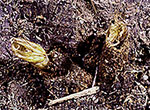
Figure 6: Pupal skins extruding from base of a tree after adult emergence. Photograph courtesy of David Shetlar, Ohio State University |
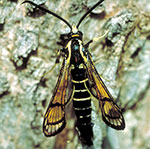
Figure 7: Peachtree borer, adult male. |
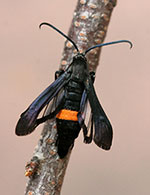
Figure 8: Peachtree borer, adult female. Photograph courtesy of David Leatherman. |

Figure 9: Peachtree borer males attracted to a trap baited with a sex pheromone lure. |
Peachtree borer (Synanthedon exitiosa) is the most destructive insect pest of peach, cherry, plum, flowering plum and other stone fruits (Prunus spp.) in Colorado (Figure 1). The grublike larvae chew underneath the bark at the base (crown) of the tree and on larger roots, habits that lend it another common name “peach crown borer” (Figure 2). The gouging wounds they produce can be quite extensive and may seriously weaken and even kill trees, but may not be obvious unless the area around the base of the tree is examined.
External evidence of peach tree borer tunneling is a wet spot on the bark or the presence of oozing, gummy sap. The sap is clear or translucent and often dark from the sawdust-like excrement of the insect. Most injuries occur along the lower trunk beneath the soil line. Lower branches rarely receive injuries. (Note: Oozing wounds on peach that produce an amber-colored gum may be caused by cytospora canker http://extension.colostate.edu/topic-areas/agriculture/cytospora-canker-in-tree-fruitcrops-2-953, a common fungal disease of stone fruits that produces symptoms that may be mistaken for those produced by peachtree borer. The presence of small particles of wood and bark within the gum distinguish damage by peachtree borer.)
Life History and Habits
The life cycle of the peachtree borer requires one year to complete. Only the immature (larva) stage (Figure 3) produces the damage to trees. Upon hatching from the eggs (Figure 4), young larvae immediately tunnel into the sapwood of the tree, usually through cracks and wounds in the bark. Larvae continue to feed and develop until the onset of cold weather. Most activity occurs a few inches below ground on the trunk and larger roots. The insects spend the winter as partially grown larvae below ground under the bark.
With the return of warmer soil temperatures larvae resume feeding and most injury is produced in mid-to late spring as the larvae mature. The larvae finish feeding and change to the pupal stage in late May through early July. Pupation occurs in a cell made of silk, gum and chewed wood fragments, located just below the soil surface (Figure 5).
The adults emerge within a month and in the process often will pull out the pupal skins, which may be then be seen around the base of the trunk (Figure 6). Adults of the peachtree borer (Figures 7, 8) are a type of “clearwing borer” moth that resemble wasps, but they are harmless and incapable of stinging. Unlike most moths peachtree borers (and other clearwing borers) fly during the day time.
The first adults, males, may emerge in as early as mid-June. However, females usually follow by a couple of weeks and most adult activity – mating and egg laying – occurs during July and August. During this time the female moths lay eggs on the bark of the lower trunk and in soil cracks near the tree base. Eggs generally hatch in about 10 days.
Preventive Sprays
Peachtree borer is most easily controlled by sprays of insecticides applied to the lower trunk and base of the tree. These are preventive sprays that target the eggs and early larval stages exposed on the bark of the tree. Once larvae have migrated into the tree, insecticides are not effective.
Depending on seasonal temperatures one can expect peachtree borer to begin laying eggs in very late June or early July. Most all eggs will be laid during July and August, although a few adults may still be present into September.
A way to best determine when adult peachtree borers are locally active is through use of traps. Various designs of traps, usually with a sticky bottom, are used and all capture adult males. These are lured into the trap by a chemical (sex pheromone) that mimics what female peachtree borers use to attract mates (Figure 9). Such traps can give one an idea of when adults are present, which is associated with periods when eggs are being laid.
In the absence of using these traps, as a general guideline, preventive trunk sprays should be applied around the first week of July. Where large numbers of peachtree borers continue to be active later in summer it may be useful to make a second application in early August.
To be effective as a preventive spray, the insecticide must have some residual activity, allowing it to kill young peachtree borer larvae emerging from eggs for several weeks after application. Presently certain formulations containing the active ingredients permethrin (Astro, Hi-Yield 38, etc.) or carbaryl (Sevin) are the only insecticides that can legally be used backyard fruit trees, have reasonably good residual activity on bark after application, and are labeled for control of peachtree borer.
* Colorado State University Extension entomologist and professor, bioagricultural sciences and pest management. 3/02. Revised 1/18.
Go to top of this page.





